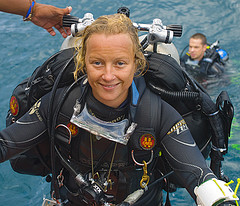
FEMALE TECHNICAL DIVERS

Female technical divers certainly seem to be in the minority so I was very happy to teach my first female student her Tech Deep Course and have an all girls tech team. This section of the diving community seems to be as male dominated as recreational diving was not too many years ago. However once there were more female instructors, there were more female students - so maybe the same will follow with technical diving?
Technical diving isn’t for everyone male or female aside. The diver must be an experienced, capable and strong recreational diver and must make a time and financial commitment train for technical diving. By training as a technical diver you are agreeing to accept the increased risks that come from exceeding the no decompression limit. Females are naturally more cautious which I believe inhibits their participation yet ironically caution is a strong trait in any good technical diver. If you are female you might also be concerned about all the gear, its weight and your physical strength. I’ve written this report about our course to hopefully answer some of those concerns.
Yes - there is a lot of gear and yes it is heavier than your recreational kit but as you can see we were managing to stand up,smile and even pose for a photo. Dunja, my student, is also a recreational instructor so we are both of average fitness and diving regularly.
Once you are in the water the kit becomes more manageable - the same as your recreational kit does. Yes there is more of it but if you understand how your recreational kit works then you’ll understand this. Your kit, simply put, is doubled. You take 2 of everything, just to be sure, because if you have decompression obligations you no longer have direct access to the surface. In an emergency you need to be able to deal with the problem underwater. Clealry you need more air because you are going deeper - hence the twin tank set up. However, if you wish, you can start your introductory training with one high capacity cylinder.
During your training you will learn about the differences in kit set up and practice skills that will teach you how to use all. For example, in a twin tank set up, the regulator that you breathe from is on a long hose routed around your neck and torso. In an out of air situation it is this one you pass off, unlooping it, and switching to your alternate which is hung on a bungee necklace around your neck. You will learn how to shut down your tank valves should you have a free flow and you will progress to handling deco and stage tanks too.
I complete my courses on a 3 day technical liveaboard to visit ship wrecks in the Gulf of Thailand. By the time were swimming around at 50m, Dunja had completed 10 of her 12 dives for the course. The dives start at just 10m deep gradually progressing you to simulated decompression dives before you are into the real thing. Dive and gas planning are learnt in the classroom over several theory sessions, culminating in exams.
The boat that I use has a oxygen decompression station positioned under the boat on a trapeze like structure with 6m and 4.5m bars. You can while away your last decompression stop comfortably watching the ocean go by.
Hopefully this will answer a few questions for any ladies out there considering furthering their dive education.
Written by Ayesha Cantrell, Thailand.